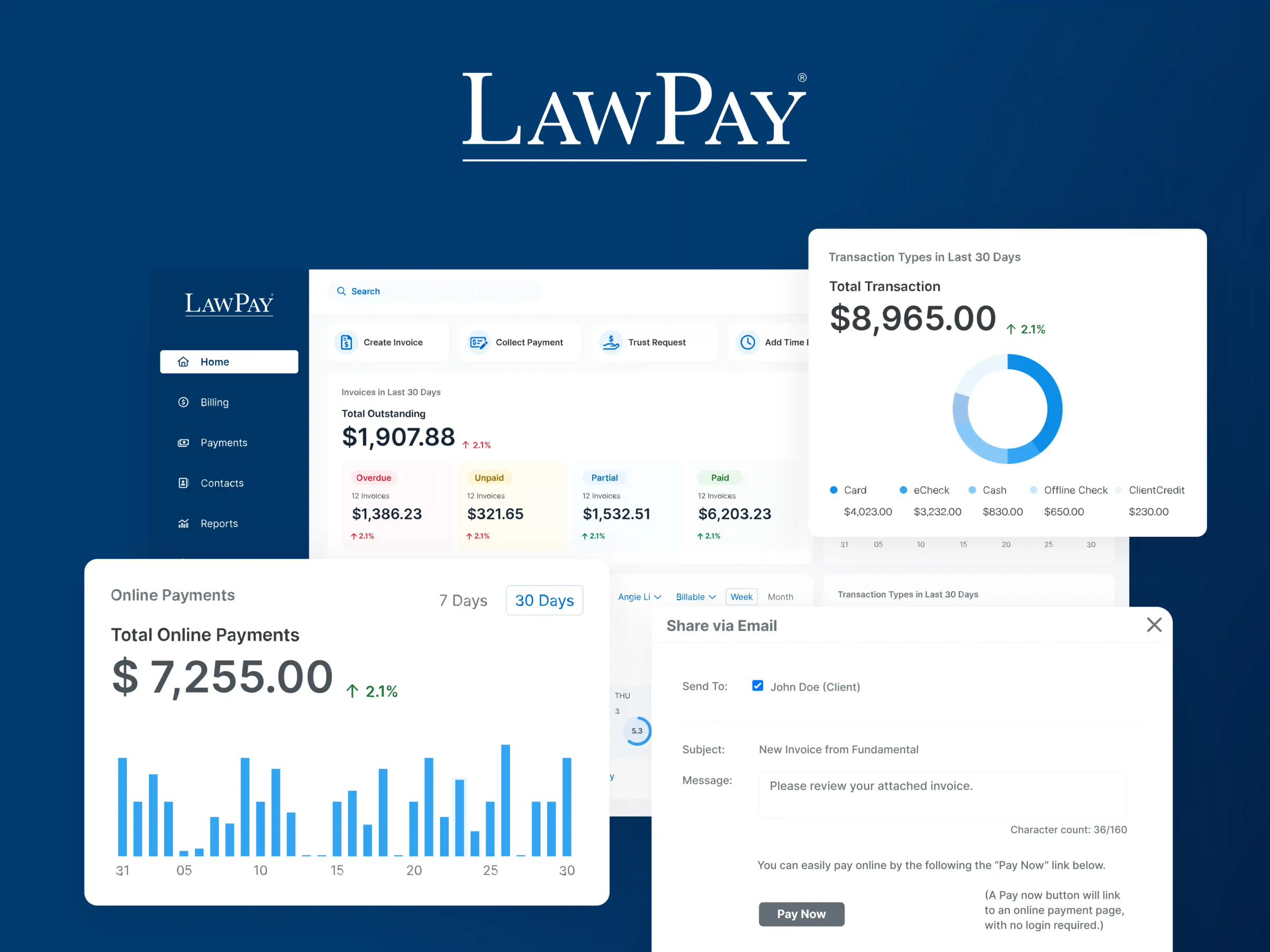Effective billing arrangements and efficient billing processes are crucial for the ongoing success of your practice. Choosing your ideal billing arrangement—such as hourly or flat rate—enables profitability and better client service, while streamlining your billing workflows can improve collections and free up time to focus on planning for your firm’s future success.
This blog article will guide you through the process of optimizing every aspect of your firm’s billing, from determining the right billing structure and rates to improving processes and avoiding common pitfalls. Get the essential information you need to tackle what’s next with confidence.
Schedule a demo to see what LawPay can offer your firm.
Book Now
What is law firm billing, and what does it look like?
Did you know that, in 2021, lawyers recorded an average of 2.5 billable hours in an eight-hour day? Their time was spent mainly on administrative duties, including invoicing, processing payments, and updating trust ledgers.
Law firm billing is one area that takes up a lot of time. It's so central to the success of a business that it's surprising how many firms neglect to spend the necessary time on getting their billing systems right. While one size does not fit all, there is a standard practice for law firm billing procedures. Your firm relies on getting paid and paid quickly to stay afloat.
A clean, concise, and consistent billing process is the way to ensure that happens. The process usually begins when your firm receives a new client call or email and opens a new matter for an existing client.

The attorney billing process typically involves the following steps:
The attorney and the client agree on the terms of representation, including the billing method (hourly, flat fee, or hybrid).
The attorney begins working on the case and keeps track of the time spent on the matter.
3.The attorney prepares a bill for the client, which typically includes a breakdown of the time spent on the case, the hourly rate, and any expenses incurred. 4. The client reviews the bill and may request an explanation for unclear charges. 5. The client pays the bill, either in whole or in installments. 6. The attorney continues to work on the case and sends additional bills to the client as necessary.
This is a straightforward process. Despite that, several bottlenecks may arise: delays in opening new matters, attorneys not logging billable hours in time, and bills being sent out late. Keep reading to learn how you can build your billing and payment policy to mitigate the potential for time waste and errors.
Lay the foundation of your Billing Policy
We will walk you through a step-by-step process to build a stellar billing policy; however, we urge you to check off a couple of boxes before creating a plan. Before making your firm's billing policy, here are some steps to ensure that your process is built on a firm foundation.

Establish your hourly rates: Determine your hourly rates based on your experience level, the complexity of your cases, and the market rates for legal services in your area.
Determine your billing methods: Decide whether you will bill clients on an hourly basis, a flat fee basis, or a combination of both. Consider the complexity of your cases, your hourly rate, and any costs associated with the case, such as filing fees or expert witness fees.
Set payment terms: Determine when and how clients will pay their bills. You may require clients to pay a retainer upfront, or you may bill them periodically throughout the case. Consider offering different payment options, such as checks, credit cards, or electronic payments.
How to set your firm's rates
Like any professional, attorneys have a wide variety of options when determining how much they are paid. How a law firm sets its prices can dramatically impact the success of its business.
Unfortunately, there's no magic formula for determining the amount you should charge your clients. Here are a few tried-and-true factors to consider when setting your law firm's rates:
Market rates: Research the going rates for legal services in your area. Consider the rates of other law firms in your practice area and what clients are willing to pay for legal services.
Experience and expertise: Consider your experience and expertise in your practice area. Attorneys with more experience and specialized knowledge may be able to charge higher rates.
Competitor rates: As you survey the marketplace, pay attention to more than just what other practices are charging. How do they structure their fees? It's possible to come up with an alternative pricing model that is more appealing to clients. Also, take note of what services other firms provide and don’t provide. You might be able to add value—and ask for higher rates—by filling in those gaps.
Take note of what services other firms provide and don't provide. You might be able to add value - and ask for higher rates - by filling in those gaps.
However, you should be cautious about setting your price points lower only to compete with other firms in your area. Don't set price points purely to gain an advantage over your competitors.
Overhead costs: Determine your overhead costs, such as rent, utilities, and staff salaries, and factor these costs into your rate calculations.
Client expectations: Consider your target client base and what they are willing to pay for legal services. If you are targeting high-income individuals or businesses, you may be able to charge higher rates.
Value of your services: Consider the value your legal services provide to your clients. If you can resolve a legal matter efficiently and effectively, you can justify higher rates.
Determine the proper billing arrangements for your firm
Clients must understand how their law firm bills for legal services, as this can significantly impact the overall cost of their legal matter. Clients should discuss billing arrangements with their attorneys in advance to ensure they are comfortable with the billing method and understand what is included in the fee.
Billable hours
Hourly billing is the most common billing method in the legal industry. The law firm charges the client for the time spent working on the case, including the time spent on research, drafting documents, attending court hearings, and communicating with the client. The hourly rate for legal services can vary significantly depending on the case's complexity, the attorney's experience, and the law firm's location.
Limited scope representation
You should discuss the limitations of limited scope representation with your client in advance to ensure they understand the scope of the legal services being provided.
Limited scope representation, also known as "unbundled" or "à la carte" legal services, refers to a legal arrangement in which an attorney provides a specific, limited set of legal services to a client rather than handling the entire case from start to finish. Examples include: providing legal advice and counsel, drafting legal documents, or negotiating a settlement agreement.
Clients need to understand that limited scope representation does not provide the same level of representation as full representation and that the attorney may not be able to advocate fully on the client's behalf. You should discuss the limitations of limited scope representation with your client in advance to ensure they understand the scope of the legal services being provided.
Sliding scale rates
In this fee structure, the attorney's hourly rate or flat fee varies based on the client's income or ability to pay. The attorney may use a predetermined scale, such as the federal poverty guidelines, to determine the appropriate fee for the client.
Legal aid organizations, pro bono programs, and other non-profit legal services providers often use sliding scale legal fees to make legal services more accessible to low-income individuals and families. Private law firms may also use them to provide reduced fees to clients who cannot pay the total cost of legal services.
It is important for clients to understand that sliding scale fees may still be substantial and that they may be responsible for paying for the costs of their case and the attorney's fees.
Sliding scale legal fees can be a good option for clients who cannot afford full representation but still need legal assistance. It is important for clients to understand that sliding scale fees may still be substantial and that they may be responsible for paying for the costs of their case and the attorney's fees.
Flat rate
Unlike other fee arrangements, this type charges the client a flat rate for each matter or case regardless of how much time is spent on it. A flat fee may be preferable to clients who want to be sure that their bill will be consistent.
If you use this arrangement, be careful not to underestimate the required work and set too low a fee. You must do your due diligence.
Contingency fee
In a contingency fee arrangement, the client pays only if the case is won. Personal injury cases and class actions typically use this type of arrangement. It serves an essential function for individuals who cannot pay out of pocket for representation.
These arrangements generally pay the attorney a percentage of the overall award. You should consider the risk that you may not be paid if you choose to work under this arrangement.
Evergreen retainers
This type of retainer is sometimes called a "rolling retainer" or a "standing retainer." An evergreen legal retainer is a retainer agreement that is automatically renewed periodically unless the client or the attorney terminates the agreement.
Payment plans
Offering a payment plan may be critical to your firm getting paid. Paying out a lump sum may be difficult for cash flow purposes for clients. By offering weekly or monthly payment plans, you can provide an additional service to clients and build goodwill while also getting paid. Having clear, written guidelines on collections and payment methods is key.
You can also consider using fee funding to provide incremental payment options. Pay Later is a legal fee financing solution exclusively available through LawPay. With Pay Later, you receive the total invoiced amount at the start of an engagement while still being able to offer clients the option to pay a loan for legal fees in automated installments.
How to create your firm's billing policy
Having a clear and transparent billing policy establishes trust and builds a good relationship with your clients. By following these steps, you can create a billing policy that is fair, competitive, and aligned with the needs of your law firm and your clients.

1. Create a template
Standardize and templatize your law firm billing procedures by including the following:
When to send invoices.
How long the descriptions should be.
What expenses must be included on bills versus what should be written off.
Any standard introductory communications on bills, if needed.
Investing early on in a transparent and accessible billing and expense process will save you time in the long run.
2. Develop a workflow
Get to know your billing lifecycle. How do your law firm billing procedures work? You should be able to answer the following questions quickly:
Which attorneys on a case need to review a bill?
In which order?
Are bills mailed or sent electronically?
Who should one inform when sending a bill out?
Write out your entire process from start to finish, so there's no confusion—even if you're a solo attorney. This understanding helps support your bottom line, and helps you better understand your clients, giving you momentum to invest in the client-centered experience.
3. Collaborate with the finance department
Ensure your accountant or finance team knows when your firm is sending clients bills, what's still owed, and what's being written off. Communication gaps can lead to confusion and payment delays.
4. Create a transparent policy towards clients
Your clients should be well-acquainted with your billing policy, so they're clear on the following:
When and how often bills will arrive
The different payment methods available
How much time clients have to pay
The consequences for late payments
Tips for law firm billing
To save your law firm valuable time and money, having a clear, standardized law firm billing policy in place is essential. Here are some additional best practices to ensure your firm is billing as efficiently and effectively as possible.
Use a legal billing software
Legal billing software can help law firms to improve the accuracy, efficiency, transparency, and security of their billing processes, which can ultimately help to build stronger relationships with clients and improve financial performance.
There are several benefits to consider when deciding if your firm should use legal billing software.
Using online payment software, you and your firm will:
Ensure that bills are accurate and complete, reducing the risk of errors or discrepancies.
Streamline the attorney billing process, making it easier to track time, generate invoices, and manage payments.
Provide clients with detailed, real-time visibility into their billing status and help to build trust and transparency.
Get paid faster by automating the invoicing and payment process.
Protect sensitive client data by providing secure, encrypted storage and transmission of billing information.
LawPay is a payment service specifically designed for lawyers and law firms. Our robust online payment and billing software provides a range of features that can help lawyers and law firms streamline their payment and billing processes and improve their cash flow.
Credit card processing: LawPay allows you to accept credit card payments from clients, including Visa, Mastercard, and American Express.
Electronic check processing: LawPay allows you to accept electronic check payments from clients, which can be a convenient and secure alternative to paper checks.
Automated billing: LawPay's Quick Bill feature allows you to set up automatic billing for recurring payments, such as retainer fees or monthly payments.
Customized invoicing: LawPay allows you to create customized invoices that reflect your law firm's branding and include detailed descriptions of the services provided.
Online payment portal: LawPay provides an online payment portal that allows clients to securely make payments online.
Mobile app: LawPay offers a mobile app that allows you to manage your payments and invoicing on the go.
Security: LawPay uses advanced security measures to protect your and your clients' personal and financial information.
Communicate with the client
Communicate your billing policy to clients in writing, either in a retainer agreement or a separate billing policy document. Include details on your hourly rates, payment terms, and any additional costs that may be incurred. Determining when and how clients will pay their bills is also crucial.
Your clients will likely be unfamiliar with legal jargon or certain abbreviations. If they can easily understand the charges on their bill, there's less of a chance they'll contest them or find them suspicious.
Bill consistently
Plan a consistent time and date to send your bill out every month. This ensures your client can anticipate your bill and pay it more promptly. The routine can also reinforce your habits of recording your time diligently and regularly.
Keep invoices simple with key information
You want to record every task you've performed for your client's case, including every significant step. Many legal professionals will record their tasks in 10-15 minute increments, with some going as detailed as six minutes at a time.
All invoices should include several key elements:
Contact information for both your firm and the client.
Invoice number for quick referencing.
Your law firm's billing codes.
This way, you can keep track, at a high level, of which tasks or expenses you are billing to the client.
Accept credit card payments
Accepting credit cards can provide numerous benefits to lawyers, including increased convenience, expanded payment options, improved cash flow, increased security, and appeal to a more modern clientele.
Your clients expect the convenience of electronic payments. Modern clients are busy and prefer to avoid the hassle of coming into an office to pay in person. Our data shows the collection rates for law firms that accept online credit and debit payments are nearly 10% higher than those that don't.
Legal Billing Mistakes to Avoid
Billing on Routine Office Tasks: Though it's good to be thorough with your billing, don't go overboard with your charges. For example, you shouldn't be recording menial office tasks such as using a printer or a stapler. The cost of having and maintaining standard office supplies should come out of your pocket, not your client's.
Sitting on Bills: When your bill is ready to go, don't delay sending it out. The best time to send out your bill is as close to Day Zero as possible. This way, the case is still fresh in their mind, and payment for your services feels appropriate and warranted.
Restricting Options for Clients to Pay Bills: Studies have shown that 80 percent of people prefer to make purchases using credit or debit cards, and we can assume this includes legal services. When you give your clients multiple options, you eliminate the chances of payment becoming difficult for them. By using an online payment solution designed specifically for the legal industry, like LawPay, your clients will always have an easy bill-paying experience.
LawPay Gets You Ready for What’s Next
Schedule a demo to see what LawPay can offer your firm.
Book Now
Managing effective billing arrangements and legal billing processes can be frustrating and time-consuming, but it doesn’t have to be. With the right law firm technology, you can optimize your invoicing and payment processes, improve productivity and profitability, and free up time to focus on your firm’s strategic goals.
Discover how LawPay’s end-to-end invoicing and payments solution can help you get ahead of what’s next. Schedule a demo today.
About the author

Hannah DeFreitasSenior Content Writer
Hannah DeFreitas is a Senior Content Writer for leading legal software brands, including MyCase, Docketwise, CASEpeer, and LawPay—the #1 legal payment processor. She distills industry trends and data into strategic insights that empower legal professionals to streamline workflows, increase revenue, and gain a competitive edge.
